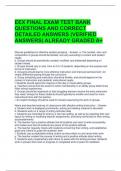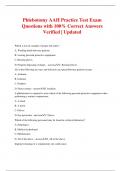EEX FINAL EXAM TEST BANK
QUESTIONS AND CORRECT
DETAILED ANSWERS (VERIFIED
ANSWERS) ALREADY GRADED A+
Discuss guidelines for effective student grouping. - Answer- a. The number, size, and
composition of groups should be flexible, and vary according to content and student
needs.
b. Groups should be periodically created, modified, and disbanded depending on
student needs.
c. Groups should vary in size, from to 2 to 10 students, depending on the purpose and
format of instruction.
d. Grouping should lead to more effective instruction and improved achievement, not
simply differential pacing through the curriculum.
e. Group scheduling and instruction should be flexible, and should depend on the
content of instruction and students' instructional needs.
f. Students should spend the majority of the day in mixed ability groups.
g. Teachers should limit the extent to which membership in an ability group determines
other school experiences.
h. Groups should be organized so that struggling learners receive the extra instruction
they need. Groups for these students should typically be smaller and meet for more
instructional time with the teacher.
i. An explicit strategy should be used for closely supervising the work of groups.
Name and describe features of classrooms with effective writing instruction. - Answer-
a. Student work is displayed prominently; writing and reading material is abundant
b. Students work on a range of writing activities daily
c. Students are motivated to write by a risk-free setting, as well as by selecting their own
topics for writing or modifying teacher assignments, and being reinforced for their writing
accomplishments
d. The teacher has a positive attitude that all students can learn to write successfully,
and makes sure that all students are aware of this positive attitude
e. The teacher regularly meets with students concerning their writing, and establishes
goals and criteria to guide the students' work
f. Students use a predictable writing routine as they reflect on and revise their work
g. The teacher models the process of writing and a positive attitude about writing
h. Students work cooperatively with others to assist with the writing process. Students
work to present their work in progress or completed work to peers for feedback
,i. The teacher provides instruction that addresses necessary skills, including
phonological awareness, handwriting, spelling, writing conventions, sentence-level
skills, text structure, the functions of writing, and planning and revising
j. Teacher provides follow-up, targeted instruction to ensure that all students master
necessary writing skills
k. Writing skills are integrated across the curriculum
l. Teachers provide students opportunities to self-regulate writing by working
independently, arranging their own space, and seeking help from others
m. Teacher frequently assesses writing progress, strengths, and needs
n. Teachers conduct conferences and communicate with parents regarding the writing
program and students' progress as writers
Name and describe principles of research-based instruction in core content areas. -
Answer- a. Step 1: Provide high quality core instruction in the general education
classroom.
i. This instruction should be well organized, explicit, and routinely provide students with
opportunities for cumulative review of content that was previously mastered. High
quality core instruction in general education classrooms is characterized by good
classroom management; balanced teaching of skills; student supports or scaffolding for
learning new content; integration of curriculum across content areas whenever possible;
and support for students in developing skills for self-regulation.
b. Step 2: Increase the time students spend learning key academic content.
i. In most instances, students who struggle with reading should participate in general
education reading instruction. This instruction should be differentiated to meet the
needs of students who are struggling to learn the content. More intensive instruction
should be provided in the general education classroom during this reading block using
methods such as PALS. Still more intensive interventions that are needed and that
cannon be provided in the general education classroom should be delivered in addition
to this instruction, and should not supplant high-quality general education instruction.
c. Step 3: Differentiate instruction in the general education classroom to meet student
needs.
i. All students will benefit from lessons that provide background information regarding
material to be learned, or exercises that build skills related to content. Teachers should
also provide some instruction in inclusive classrooms that differentiates activities or
instruction based on individual student needs using activities such as peer tutoring,
cooperative learning structures, center-based instruction, and small group instruction.
d. Step 4: Closely integrate interventions with gener
What is cooperative learning and what are common characteristics of cooperative
learning groups? - Answer- a. Cooperative learning is a grouping strategy that uses
mixed-ability groups for instruction. The goal of this strategy is to ensure that all
students learn assigned content, which may range from basic academic skills to
complex content that involves group projects.
b. Step 1: The teacher divides the class into four to six-person Jigsaw groups.
, i. Group composition should be based on the individual strengths of each student, and
groups should be diverse in relation to gender, ethnicity, and ability. One person should
be appointed as the group leader.
c. Step 2: The teacher divides the day's lesson into four to six components.
d. Step 3: Each student is then assigned to learn one segment.
i. The teacher ensures that each student has access only to information regarding her
segment of the assignment.
e. Step 4: Each student reads her assignment at least twice and becomes familiar with
the information.
i. Students then form temporary expert groups, by having one student from each group
join other students who are assigned to learn the same segment. Students in these
expert groups then discuss their segment, and rehearse the presentations they will
make to their Jigsaw group.
f. Step 5: Students return to their Jigsaw groups and present information regarding their
segments to the other group members. All group members are encouraged to ask for
clarification.
g. Step 6: During these activities, the teacher floats from group to group, observes, and
intervenes if any group is having difficulty.
h. Step 7: At the end of the session, students may be required to produce a product with
their completed work or take a quiz regarding the content of the lesson.
Name and describe four preventive practices related to classroom organization and
management. - Answer- a. Arranging the Physical Environment
i. Make effective use of physical dimensions of classroom
ii. Arrange furniture and materials for accessibility, instructional effectiveness,
appropriate social interactions, and safety
iii. Design as a function of (1) layout and location; (2) age, number, and behavioral
profiles of students; and (3) levels of supports required by students with disabilities
b. Valuing Instructional Time
i. Highlighting policies that encourage and reinforce attendance and punctuality
ii. Ensuring that adequate time is devoted to task-relevant activities
iii. Explicitly teaching and conducting transitions between and among activities efficiently
with little disruption
c. Being Prepared
i. Organized/easy to follow lesson plans
ii. Start lessons promptly
iii. Have materials close by
iv. Maintain a consistent schedule
d. Coordinating Resources
i. IEP-monitoring procedure that promotes instructional support and accountability
ii. Substitute teacher packet that highlights the essential information one would need to
teach and manage the class during short-term absences
iii. Readily available resource guide of school and community services that can address
critical needs presented by students/families





